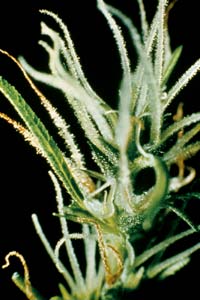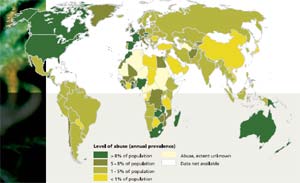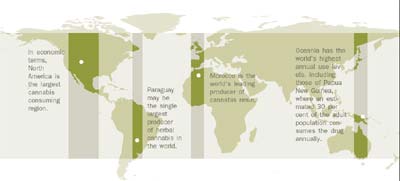Why should we care about cannabis?
Approximately 4 per cent of the world's adults-some 162 million people-use cannabis every year, making it the world's most widely used illicit drug. In spite of this, many basic facts about cannabis remain obscure.

By Ted Leggett
The 2006 UNODC World Drug Report devotes special attention to cannabis, arguing that the world should take this drug more seriously. Of particular concern are the growth in the drug's potency and indications that cannabis-related mental health risks may have been underestimated.
As cannabis can be grown in virtually any country, unlike most other illicit drugs, it is difficult to establish the exact origin of the world's supply. Very few Governments can give an accurate estimate of the number of hectares grown in their own countries, and the amount of cannabis these fields produce can vary widely. Furthermore, cannabis is increasingly grown indoors in the developed nations, which means that users can, and do, grow their own.
Our understanding of cannabis consumption patterns is little better. In most markets, cannabis is relatively cheap, and unlike other drugs, it is not sold by precise weight. Surveys indicate that most users get the drug for free or buy it through friends and acquaintances. Casual users generally consume cannabis in groups, and only a small amount of the drug is necessary to produce the desired high. Most users would find it difficult to say how much cannabis they actually smoke.
Diverse global markets
Cannabis is the dominant illicit drug in every region of the world and its use is growing almost everywhere. While not every cannabis market is transnational, in the sense that production occurs in a different country from consumption, the problem is truly international.
In economic terms, North America is the largest cannabis-consuming region. Mexico alone is responsible for more than one-third of global herbal cannabis seizures. In spite of an aggressive eradication campaign, the country still supplies a large share of the massive United States market. High-potency indoor cannabis has come to dominate the Canadian market, which is another source of significant imports in the US.
USE OF CANNABIS 2003-2004 (or latest year available)
Source: World Drug Report 2006
(click on image to enlarge)
Africa comes second in the world in terms of herbal cannabis seizures, which is remarkable given the continent's limited law enforcement capacity. Africa is also home to the world's leading producer of cannabis resin, Morocco. Southern, West and East Africa all contain large cannabis-producing countries, but there is little specific data available about the scale of cultivation.
It is difficult to reconcile what is known about cannabis production in Central and South America with the available information on the extent of cannabis use in the region. Although surveys indicate a relatively small user population, large cannabis seizures take place regularly. Moreover, with the exception of Colombia, no country is known to be a major exporter beyond the region. Paraguay is reportedly the main source of the cannabis consumed in the Southern Cone and Brazil, and may be the single largest producer of herbal cannabis in the world.
The risk of becoming dependent on cannabis is higher
than most casual users suspect. Around 9 per cent
of those who try cannabis are unable to stop using it.
Oceania has the world's highest annual usage levels, including those of Papua New Guinea, where an estimated 30 per cent of the adult population consumes the drug annually. Most countries in this region appear to be self-sufficient in their cannabis supply.
While much of Europe still prefers cannabis resin to herbal cannabis, this appears to be changing in many important markets. The Netherlands, which has been in the vanguard of the indoor cannabis revolution, is named as an important supplier to at least 20 other countries. In Eastern Europe, Albania plays a similar role. Most of the cannabis resin in Europe continues to be imported from Morocco, however.
Per capita usage levels are low in Asia, but because of its large population, the continent is home to the largest absolute number of cannabis users, an estimated one-third of the global total. A national survey has shown that 2.3 million people are dependent on cannabis in India alone. Central Asia is home to the world's largest wild cannabis fields, but it remains unclear to what extent these crops are harvested.
(click on image to enlarge)
Potency growth and mental health implications
In recent years, the potency of sinsemilla cannabis, made from the unfertilized buds of the female plant, has doubled, according to studies done in key markets such as the Netherlands, the United States and Canada. This is not surprising as cannabis breeders in these countries have been hard at work creating a more potent drug since the 1970s. And while sinsemilla is currently less widespread than herbal cannabis (marijuana) and cannabis resin (hashish), the market for high-potency, indoor-produced sinsemilla appears to be growing in many key consumption countries.
Recent research indicates that cannabis consumption may have greater mental health implications than previously believed. These two trends may in fact be related: as high-potency cannabis grows in popularity, the risks of consumption may become more immediate.
While more research is required to determine the impact of the 'new,' more potent cannabis, there has been an increase in the number of people complaining of 'unexpected effects' from consuming cannabis in emergency rooms in the United States. Demand for treatment for cannabis-related problems in the US and Europe has increased as well.
|
|
TYPES OF CANNABIS Several drug types can be produced from the cannabis plant.
|
Finally, the risk of becoming dependent on cannabis is higher than most casual users suspect. Around 9 per cent of those who try cannabis are unable to stop using it. Even when used only once, cannabis can produce panic attacks, paranoia, psychotic symptoms and other negative acute effects. The drug may also precipitate psychosis in vulnerable individuals and aggravate symptoms in diagnosed schizophrenics.
Cannabis is the dominant illicit drug in every region of the world,
and its use is growing almost everywhere.
Ted Leggett is an expert in the Research and Analysis Section of UNODC.
For more information, please consult the World Drug Report at www.unodc.org/world_drug_report.html


